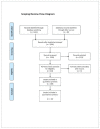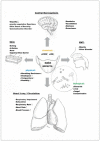Is a Mask That Covers the Mouth and Nose Free from Undesirable Side Effects in Everyday Use and Free of Potential Hazards?
- PMID: 33923935
- PMCID: PMC8072811
- DOI: 10.3390/ijerph18084344
Is a Mask That Covers the Mouth and Nose Free from Undesirable Side Effects in Everyday Use and Free of Potential Hazards?
Abstract
Many countries introduced the requirement to wear masks in public spaces for containing SARS-CoV-2 making it commonplace in 2020. Up until now, there has been no comprehensive investigation as to the adverse health effects masks can cause. The aim was to find, test, evaluate and compile scientifically proven related side effects of wearing masks. For a quantitative evaluation, 44 mostly experimental studies were referenced, and for a substantive evaluation, 65 publications were found. The literature revealed relevant adverse effects of masks in numerous disciplines. In this paper, we refer to the psychological and physical deterioration as well as multiple symptoms described because of their consistent, recurrent and uniform presentation from different disciplines as a Mask-Induced Exhaustion Syndrome (MIES). We objectified evaluation evidenced changes in respiratory physiology of mask wearers with significant correlation of O2 drop and fatigue (p < 0.05), a clustered co-occurrence of respiratory impairment and O2 drop (67%), N95 mask and CO2 rise (82%), N95 mask and O2 drop (72%), N95 mask and headache (60%), respiratory impairment and temperature rise (88%), but also temperature rise and moisture (100%) under the masks. Extended mask-wearing by the general population could lead to relevant effects and consequences in many medical fields.
Keywords: MIES syndrome; N95 face mask; adverse effects; contraindications; dyspnea; headache; health risk assessment; hypercapnia; hypoxia; long-term adverse effects; masks; personal protective equipment; physical exertion; risk; surgical mask.
Conflict of interest statement
The authors declare no conflict of interest.
Figures





Similar articles
-
Physio-metabolic and clinical consequences of wearing face masks-Systematic review with meta-analysis and comprehensive evaluation.Front Public Health. 2023 Apr 5;11:1125150. doi: 10.3389/fpubh.2023.1125150. eCollection 2023. Front Public Health. 2023. Retraction in: Front Public Health. 2023 May 25;11:1221666. doi: 10.3389/fpubh.2023.1221666. PMID: 37089476 Free PMC article. Retracted.
-
Sports despite masks: no negative effects of FFP2 face masks on cardiopulmonary exercise capacity in children.Eur J Pediatr. 2024 Feb;183(2):639-648. doi: 10.1007/s00431-023-05316-2. Epub 2023 Nov 11. Eur J Pediatr. 2024. PMID: 37950791 Free PMC article.
-
Powered Air Purifying Respirator (PAPR) restores the N95 face mask induced cerebral hemodynamic alterations among Healthcare Workers during COVID-19 Outbreak.J Neurol Sci. 2020 Oct 15;417:117078. doi: 10.1016/j.jns.2020.117078. Epub 2020 Aug 3. J Neurol Sci. 2020. PMID: 32768718 Free PMC article.
-
Is N95 face mask linked to dizziness and headache?Int Arch Occup Environ Health. 2021 Oct;94(7):1627-1636. doi: 10.1007/s00420-021-01665-3. Epub 2021 Mar 1. Int Arch Occup Environ Health. 2021. PMID: 33646335 Free PMC article.
-
Masks for Prevention of Respiratory Virus Infections, Including SARS-CoV-2, in Health Care and Community Settings : A Living Rapid Review.Ann Intern Med. 2020 Oct 6;173(7):542-555. doi: 10.7326/M20-3213. Epub 2020 Jun 24. Ann Intern Med. 2020. Update in: Ann Intern Med. 2023 Jun;176(6):827-835. doi: 10.7326/M23-0570. PMID: 32579379 Free PMC article. Updated. Review.
Cited by
-
Expert consensus on the diagnosis, treatment, and prevention of respiratory syncytial virus infections in children.World J Pediatr. 2024 Jan;20(1):11-25. doi: 10.1007/s12519-023-00777-9. Epub 2023 Dec 8. World J Pediatr. 2024. PMID: 38064012 Free PMC article. Review.
-
Orthodontic Adolescent Patients' Attitudes toward Protective Face Mask Wearing during the COVID-19 Pandemic.Medicina (Kaunas). 2022 Mar 6;58(3):393. doi: 10.3390/medicina58030393. Medicina (Kaunas). 2022. PMID: 35334569 Free PMC article.
-
Experimental Assessment of Carbon Dioxide Content in Inhaled Air With or Without Face Masks in Healthy Children: A Randomized Clinical Trial.JAMA Pediatr. 2021 Jun 30:e212659. doi: 10.1001/jamapediatrics.2021.2659. Online ahead of print. JAMA Pediatr. 2021. Retraction in: JAMA Pediatr. 2021 Sep 1;175(9):e213252. doi: 10.1001/jamapediatrics.2021.3252. PMID: 34190984 Free PMC article. Retracted.
-
[Impact of wearing face masks in public to prevent infectious diseases on the psychosocial development in children and adolescents: a systematic review].Bundesgesundheitsblatt Gesundheitsforschung Gesundheitsschutz. 2021 Dec;64(12):1592-1602. doi: 10.1007/s00103-021-03443-5. Epub 2021 Oct 25. Bundesgesundheitsblatt Gesundheitsforschung Gesundheitsschutz. 2021. PMID: 34694428 Free PMC article. German.
-
Effects of wearing different facial masks on respiratory symptoms, oxygen saturation, and functional capacity during six-minute walk test in healthy subjects.Can J Respir Ther. 2022 Jun 22;58:85-90. doi: 10.29390/cjrt-2022-014. eCollection 2022. Can J Respir Ther. 2022. PMID: 35800851 Free PMC article.
References
-
- World Health Organization . WHO-Advice on the Use of Masks in the Context of COVID-19: Interim Guidance, 6 April 2020. World Health Organization; Geneva, Switzerland: 2020. [(accessed on 7 November 2020)]. Available online: https://apps.who.int/iris/handle/10665/331693.
-
- World Health Organization . WHO-Advice on the Use of Masks in the Context of COVID-19: Interim Guidance, 5 June 2020. World Health Organization; Geneva, Switzerland: 2020. [(accessed on 7 November 2020)]. Available online: https://apps.who.int/iris/handle/10665/332293.
-
- Chu D.K., Akl E.A., Duda S., Solo K., Yaacoub S., Schünemann H.J., Chu D.K., Akl E.A., El-harakeh A., Bognanni A., et al. Physical Distancing, Face Masks, and Eye Protection to Prevent Person-to-Person Transmission of SARS-CoV-2 and COVID-19: A Systematic Review and Meta-Analysis. Lancet. 2020;395:1973–1987. doi: 10.1016/S0140-6736(20)31142-9. - DOI - PMC - PubMed
-
- Jefferson T., Jones M., Ansari L.A.A., Bawazeer G., Beller E., Clark J., Conly J., Mar C.D., Dooley E., Ferroni E., et al. Physical Interventions to Interrupt or Reduce the Spread of Respiratory Viruses. Part 1-Face Masks, Eye Protection and Person Distancing: Systematic Review and Meta-Analysis. medRxiv. 2020 doi: 10.1101/2020.03.30.20047217. - DOI
-
- Kappstein I. Mund-Nasen-Schutz in der Öffentlichkeit: Keine Hinweise für eine Wirksamkeit. Krankenh. Up2date. 2020;15:279–295. doi: 10.1055/a-1174-6591. - DOI
Publication types
MeSH terms
LinkOut - more resources
Full Text Sources
Other Literature Sources
Medical
Miscellaneous

